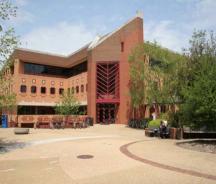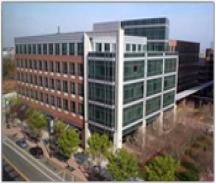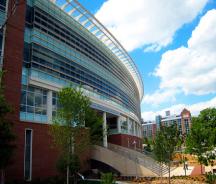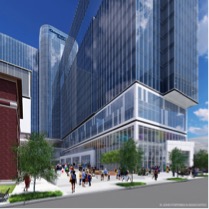(For CoC grant writers, this document is also available in PDF Format.)
Georgia Tech
Located in Atlanta, Georgia, the Georgia Institute of Technology is one of the top research universities in the United States. Georgia Tech is a science and technology focused learning institute renowned for our deeply held commitment to improving the human condition. Our faculty and students are solving some of the world's most pressing challenges: clean and sustainable energy; disease diagnosis and treatment; and national defense and security, among others. Georgia Tech is an innovative intellectual environment with nearly 1,000 full-time instructional faculty and more than 45,000 undergraduate and graduate students.
Our bachelor's, master's and doctoral degree programs are consistently recognized among the best. Georgia Tech students are equipped for success in a world where technology touches every aspect of our daily lives. Degrees are offered through the Institute's six colleges: Computing, Design, Engineering, Sciences, Scheller College of Business, and the Ivan Allen College of Liberal Arts. Year after year, Georgia Tech is consistently the only technological university ranked in U.S. News & World Report's listing of America's top ten public universities. In addition, our College of Engineering is consistently ranked in the nation's top five by U.S. News. In terms of producing African American engineering graduates, Diverse: Issues in Higher Education ranks Tech No. 1 at the doctoral level and No. 2 at the bachelor's level, based on the most recent rankings for 2021. These impressive national rankings reflect the academic prestige long associated with the Georgia Tech curriculum.
The College of Computing at Georgia Tech:
The College of Computing at Georgia Tech is a national leader in the research and creation of real-world computing breakthroughs that drive social and scientific progress. With its graduate CS program ranked 7th (2023) nationally by U.S. News and World Report, the College's unconventional approach to education is pioneering the new era of computing by expanding the horizons of traditional computer science students through interdisciplinary collaboration and a focus on human centered solutions.
The College resides and operates computing facilities in four buildings (College of Computing Building, Technology Square Research Building, Klaus Advanced Computing Building, and Coda), including more than 3,500 computers in more than 50 networks servicing three Schools, eight Research Centers, and 60 Research Labs. Faculty, staff and students are currently moving into our newest additional building, Coda, which contains a $5.3 million high-performance computing resource that will support the work of dozens of faculty, more than 50 research scientists and 200 graduate students.
Our data centers host more than 900 servers of various makes (Dell, HP, IBM, Penguin Computing, and SuperMicro), most of which are multi-processor, multi-core machines, providing over 1 PB of networked disk storage. There are several Linux-based high performance computing clusters totaling more than 1,100 physical servers and 5,600 computing processors/cores. All of the College's facilities are linked via local area networks that provide 1 Gigabit per second (Gbps) to the desktop. The College's network employs an internal high-performance, 100 Gbps Ethernet backbone to each of its buildings with external connectivity to the campus network by a 100 Gbps Ethernet uplink. Connectivity within the data center is available at 100Gbps. The Georgia Tech network is an Ethernet based IP network spanning the 150 buildings on the main campus in Atlanta, as well as remote campuses in Savannah, GA, and Metz, France. Internet services are purchased from transit providers as well as connections to research networks and transit peering services. Georgia Tech has peering with Peachnet, Southern Crossroads (SoX), TransitRail, Cogent, and Qwest at speeds of up to 400 Gbps. The Georgia Tech Research Network, through its peering with SoX, has connectivity to NLR Packetnet, Internet2 network, Oak Ridge National Labs, the Department of Energy's Energy Sciences Network (ESNet), NCREN, MREN, FLR, LONI, and 3ROX, as well as other SoX participants in the SouthEast.
The College of Computing employs a dedicated Information Technology group (Technology Services Organization, TSO) with specialists in research computing, networking, high-performance computing, and system administration. Among the tools developed and maintained by TSO are automated server deployment/configuration systems, automated inventory of all physical and virtual machines, and automated up/down and status monitoring of systems/services. TSO further acts as a link to other units/resources on campus (e.g., the PACE high-performance computing cluster) and as consultants for research computing needs.
Buildings

The College of Computing Building (CCB) houses administrative offices for the College, instructional classrooms and labs, as well as meeting space for undergraduate and graduate student organizations. CCB is home to the College’s School of Computing Instruction and is the instructional center of the College, housing 6 classrooms and 16 instructional spaces for meetings between students, teaching assistants, and instructors. The general clusters provided by OIT are available to students taking a CS course requiring specialized resources. Dedicated and spacious student common areas provide ample seating and computer networking which fosters both formal and informal learning opportunities and collaboration.
CCB also houses a 3938 sq. ft. data center providing over 1.25 Megawatts of power and cooling capacity for the College’s research and instructional computational servers. The building's advanced infrastructure provides 1 Gbps networking to all ports with a 100 Gbps uplink to the campus network as well as high-density 802.11ac wireless networking support.

The Technology Square Research Building (TSRB) is located in the innovative and pedestrian-friendly mixed-use Technology Square district of Georgia Tech and is home to the College's School of Interactive Computing, as well as more than 15 CoC research labs spanning multiple research areas including Artificial Intelligence & Machine Learning, Cognitive & Learning Sciences, Computer Graphics, Data Visualization, Human-Computer Interaction, Robotics, and Social Computing. TSRB also houses state of the art conference facilities that accommodate several of the College's special events, lectures and meetings. The College manages a 456 sq. ft. data center in the building providing 100 Kilowatts of power and cooling capacity for several research computational servers. The building's advanced infrastructure provides 1 Gbps networking to all ports with a 40 Gbps uplink to the campus network as well as high-density 802.11ac wireless networking support.
The Klaus Advanced Computing Building (KACB), dedicated in 2006, is located in the heart of the Georgia Tech campus and houses some of the most advanced computing labs and innovative educational technology in the world. The 414,000 square-foot building consists of some 70 research laboratories, 6 instructional labs, 5 large classrooms and a 200-seat auditorium. The building has a substantial number of environmental and sustainable features achieving the prestigious LEED Gold rating from the U.S. Green Building Council. Environmentally friendly features include creative use of the 6-acre urban campus site to preserve over 50 percent of the site as green space, a storm water collection system to provide water for irrigation, energy efficient heating, cooling and lighting systems, and extensive use of recyclable materials.

KACB is home to the College's School of Computer Science, and the Institute for Robotics & Intelligent Machines (IRIM). 4 research centers (CRNCH, CERCS, IDH, and ARC), over 20 CoC research labs spanning multiple research groups including High Performance Computing, Software Engineering, Databases, Systems, Theory, Computer Architecture, Networking, Programming/Algorithms, Data Analytics, and Embedded Systems. KACB houses state of the art conference facilities that accommodate several of the College's special events, lectures and meetings. The building features open collaboration spaces, study lounges, conference rooms and graduate student offices, all with ample power and networking ports. All conference rooms are equipped with projection technology, table networking and power. A highly visible conference room is equipped with a Polycom HDX 8000 video conferencing system and is available to all faculty, staff and students for conducting meetings with remote collaborators. The College manages a 579 sq. ft. data center in the building providing 80 Kilowatts of power and cooling capacity for critical enterprise servers. The building's advanced infrastructure provides 1 Gpbs networking to all ports with a 40 Gbps uplink to the campus network as well as high-density 802.11ax wireless networking support.

The Coda Building, completed in 2019, is 21 story mixed use facility home to a 93,000 sq. ft. high-performance computing data center and 605,000 sq. ft. of office space. Designed to help foster collaboration between Georgia Tech and other research and industry partners, Coda will be occupied by approximately half Georgia Tech entities, and half private companies. Groups affiliated with the College of Computing located in Coda include the School of Computational Science & Engineering (CSE), the Institute for Data Engineering and Science (IDEaS), the School of Cybersecurity and Privacy (SCP), and the Center for Machine Learning (ML@GT).
Instructional Facilities
In addition to general instructional facilities provided by the Institute, the College of Computing provides specialized instructional facilities for its advanced curriculum needs. All of the College's instructional labs and servers are located in the College of Computing Building.
- Deepspace, Rover and Shuttle UNIX Remote Access: Supporting general-purpose UNIX shell remote access, are 5-node Virtual Server clusters (4 Virtual CPUs, 8 GB RAM)
- Wingtip HPC and Data Cluster: Two Penguin Relion 2903GT GPU systems, one with an NVIDIA P100 GPU card and the second with a NVIDIA Titan Xp Pascal and Tesla K40c GPU cards. Two high-memory/multi-core Dell PowerEdge R930 systems with four Intel Xeon E7-4850 v3 (14-core) processors and 2TiB of DDR4 RAM each
- Newell Cluster: Three IBM Power System Accelerated Compute Servers (AC922). Each computer has two POWER9 16-core 2.7 GHz (3.3 GHz turbo) processor modules, SMT4 yielding 64 threads per processor module. 256 GiB DDR4 ECC memory. Two 32 GiB SMX2 NVIDIA Tesla V100 GPUs with NVLink. Dual 100Gbps Mellanox InfiniBand ConnectX5 CAPI-capable EDR adapter.
- NVIDIA DGX-1: NVIDIA's flagship data science appliance with eight 32 GiB SMX2 NVIDIA Tesla V100 GPUs. It comes configured with a suite of GPUoptimized software and simplified management tools for quick deployment and state-of-the-art computing environment for AI, analytics, machine learning, and deep learning.
- NVIDIA DGX A100: NVIDIA's flagship data science appliance with eight NVIDIA A100 GPUs. It comes configured with a suite of GPU-optimized software and simplified management tools for quick deployment and a state-of-the-art computing environment for AI, analytics, machine learning, and deep learning.
- HPC-O-RAMA: Cisco UCS cluster allowing student groups to deploy bare metal environments for testing and competitions.
- SysML cluster: 6 node cluster with 8xA40s with NVLINK and FPGAs
- Foundation VM Cluster: 40+ Node VM environment to support special topics, senior design and other courses as requested.
- Instructional Storage: High speed and archival storage for Home Directories and course storage.
- Eclipse Cluster: 8 Node cluster with 8xP80 GPUs
- COC-ICE (Instructional Cluster Environment): Funded by a technology fee grant by the College of Computing and created in partnership with the Partnership for an Advanced Computing Environment (PACE), COC-ICE is one of two ICE clusters that provides service for classes in the College. Initiated by PACE in 2018, ICE offers an educational environment mirroring production research clusters that provide undergraduate and graduate students experience working directly with scientific computing including HPC and GPU programming.
Research Facilities
An abundance of research facilities are housed in the College's Schools and Research Centers:
- The School of Computational Science and Engineering (CSE) is located in CODA and supports substantial computational facilities related to both education and research. The school is affiliated with several research centers, initiatives and labs including the Center for Research into Novel Computing Hierarchies (CRNCH), the Center for Health Analytics and Informatics (CHAI), and the Center for High Performance Computing (HPC) Laboratory. Through industrial partnerships, the HPC Lab operates or supports several state-of-the-art parallel computers and future technologies, which are readily available for teaching and research and provide a diverse collection of resources for exploration along application and computing dimensions:
- The Partnership for an Advanced Computing Environment (PACE) A facility that provides faculty participants a sustainable leading-edge high performance computing (HPC) infrastructure with technical support services. This frees faculty to focus on research while reducing their direct costs for HPC equipment and increasing productivity of students and postdocs.
The CRNCH Rogues Gallery, a CSE/CoC/ECE/IDEaS joint effort with and part of the Georgia Tech Center for Research into Novel Computing Hierarchies. These unusual and ground-breaking systems enable fundamentally new research in applications, algorithms, and systems. Current Rogues include the following:
- Emu Chick: A migratory thread system from Emu Technologies, the Chick combines eight nodes. Each node has one stationary core for servicing OS requests, eight multi-core highly multithreaded Gossamer processors, 64GiB of local memory, and a 1TB SSD. The Gossamer processors provide a single unified address space across the total of 512GiB RAM, and threads migrate so all reads are local to a node.
- Micron EX700 with AC-520 HMC + FPGA module, Nallatech 385A Arria 10, Xilinx Ultrascale MpSOC: These platforms combine reconfigurable processing (FPGAs) with either physical or emulated 3D stacked memories, enabling rapid evaluation of novel combinations of memory and logic.
- SoC Field Programmable Analog Arrays: A locally created analog version of FPGAs combines reconfigurable analogous computing with a modern toolchain to enable experiments in fundamentally new architectures like neuromorphic computing.
- AMD GPU system
- Octavius a64fx
- johnny-5 (risc-v)
For the most up-to-date listing of CRNCH Rogues Gallery resources, please visit the lab-maintained equipment listings at: https://crnch-rg.cc.gatech.edu/hosted-rogues/
- DGX A100:
- NVIDIA DGX Station: NVIDIA's flagship workstation for data science and AI workloads. Four 32GiB Tesla V100 GPUs.
- Penguin Relion XE2112: 20TB all-flash NVMe storage server for fast "scratch" storage throughout heterogeneous compute environments.
- The Computer Architecture research group is located in KACB and conducts research on all aspects of future microprocessor technology including performance, power, multi- threading, chip-multiprocessing, security, programmability, reliability, interaction with compilers and software, and the impact of future technologies.
- The Machine Learning and Perception Lab (MLP) Skynet Cluster: A growing Cluster of Penguin Computing and Ace/Supermicro systems that consists of approximately 85 nodes, 496GB RAM, with 568 Pascal, Turing and Tesla based GPUs. Sponsored by a collaborative working group of researchers comprised of faculty from the Schools of Interactive Computing and Electrical and Computer Engineering.
Georgia Tech Research Networking Capabilities
Georgia Tech's state-of-the-art network provides capabilities with few parallels in academia or industry, delivering unique and sustained competitive advantage to Georgia Tech faculty, students, and staff. Since the mid-80’s Georgia Tech and OIT have provided instrumental leadership in high-performance networks for research and education (R&E) regionally, nationally, and internationally.
A founding member of Internet2 (I2) and National LambdaRail (NLR) – high bandwidth networks dedicated to the needs of the research and education community – Georgia Tech manages and operates Southern Crossroads (SoX, the I2 regional GigaPOP). We work within six Southeastern states to make affordable high-performance network access and network services available to researchers and faculty at Georgia Tech, their collaborators, other higher-education systems, K- 12 systems, and beyond.
Georgia Tech's network has high-performance connectivity to other members of the research and education community world-wide through 100 Gbps (gigabits per second) links to SoX/SLR, which is peered with Internet2 Network, TransitRail, Oak Ridge National Labs (ORNL), the Department of Energy's Energy Sciences Network (ESNet), NCREN, NASA's NREN, MREN, FLR, Peachnet, LONI, 3ROX, as well as other SoX participants in the Southeast.
In addition to the exceptional R&E network connectivity provided to all Georgia Tech faculty, students, and staff, dedicated bandwidth in support of specific collaborations and research is also possible.